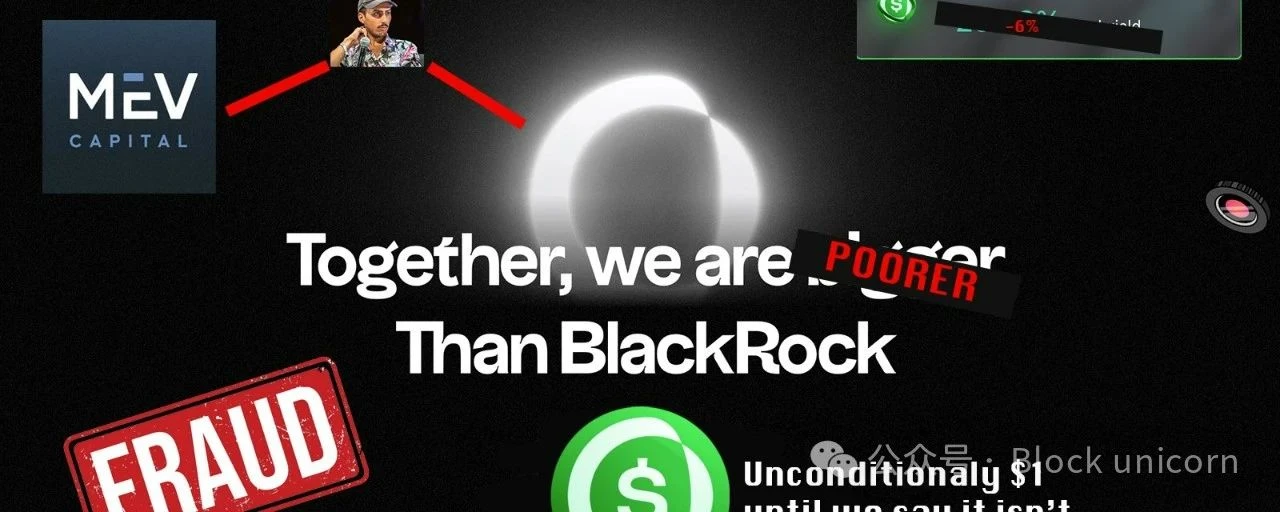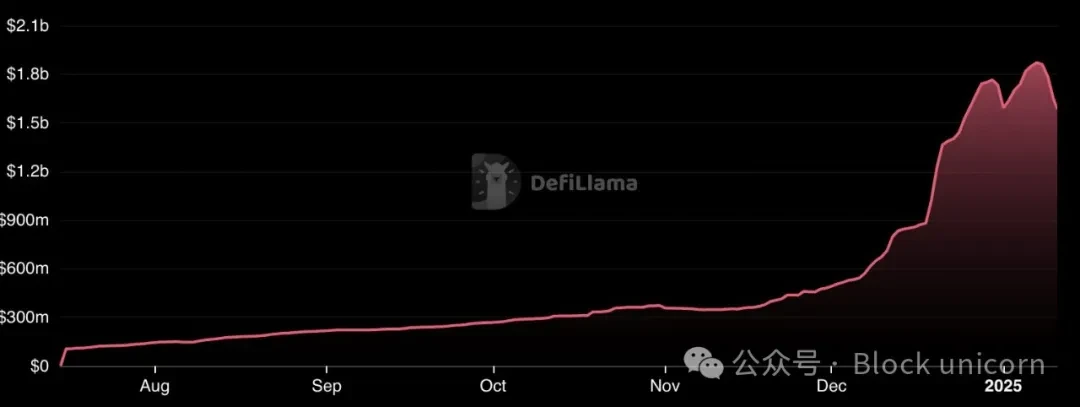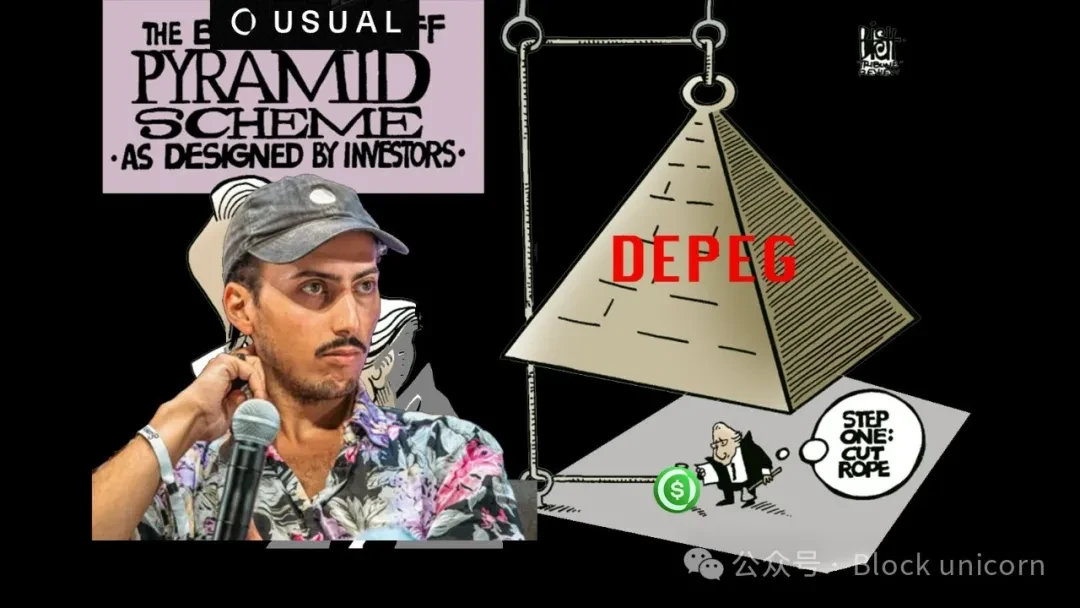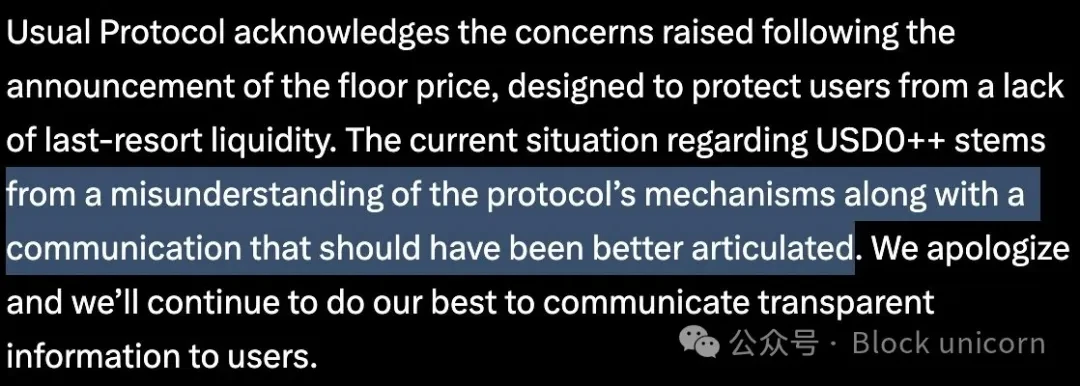USD0++ decoupling incident: lies, deception, incentives
Original author: DC | In SF
Traduction originale : Bloc licorne

Usual’s USD 0++ is currently trading for less than a dollar, yet this was supposedly part of the plan all along. Before the depeg, I was about to write a post about Usual, as it’s been getting a lot of attention lately. It’s one of the fastest growing stablecoin protocols, recently partnered with Ethena, and made a lot of money for many YT miners on Pendle. However, if you ask people what Usual does, you tend to get a variety of answers. “It gives you a yield based on RWA (real world assets).” The natural question then is: how is this different from Ondo? “Oh, it decentralizes RWA yields”, well, isn’t that also true of Maker or Sky? Etc. Etc. If you look closely, @usualmoney’s product is a token, not any actual product. Essentially, if the user gets a risk-free rate above 4%, then the source of the yield is the user themselves. But how did we get here? How did a protocol with a TVL of over a billion dollars suddenly and so quickly collapse? What exactly is the mechanism of Usual?
How do USD 0 and USD 0++ work?

USD 0 is Usual’s standard, non-yielding stablecoin. There’s not a lot to unpack here, but once you dig into USD 0++, things get interesting. Despite the similarity in name, USD 0++ is not a stablecoin per se. Initially, USD 0++ was redeemable 1:1 for USD 0, which in turn was redeemable for 1 USD. However, the project states in its documentation that sometime in Q1 2025, this will change and USD 0++ will function more like a bond, with a floor of the effective price of a US 4-year Treasury bond while paying a real underlying yield of zero. Naturally, the community assumed that this change would be announced well in advance and that there would be some process to allow users to exit if they no longer wish to do liquidity mining or choose to hold on longer and accept the higher risk that comes with it. Whatever changes occurred in Q1 2025, once this change was announced, the value of USD 0++ would drop dramatically. Holders of USD 0++ would no longer hold it purely for its USD value, but because they believed that the $USUAL tokens they would receive were worth locking up for longer.


Conflict of Interest
To facilitate liquidity mining, pools of USD 0 and USD 0++ were deployed on multiple platforms including Morpho and Euler. Morpho’s risk management was outsourced to other managers, including MEV Capital, an important player in this story. MEV Capital’s reputation is already known to be somewhat dubious in certain circles — they have previously lost investors money and covered it up with questionable accounting practices. In addition, one of MEV Capital’s shareholders, @AdliTB, is also the co-founder of Usual, which is a clear conflict of interest. MEV Capital’s role is to help lenders manage risk, not to arbitrarily direct large amounts of funds to Usual without restraint. To achieve this, MEV Capital used vaults that hard-coded the value of USD 0++ to $1. In other words, its Oracle effectively assumed that the value of USD 0++ was always $1, regardless of market price. Another well-known protocol that operates in a similar manner is Anchor, which played a key role in the UST debacle. While there may be some justification for doing so, it is irresponsible to take this approach on an asset where liquidity will eventually be removed. Euler’s oracle uses market prices to operate, leading to liquidations, and many of Usual’s pools now appear to be holding large amounts of bad debt.
1 dollar becomes 80 cents: the decoupling event

Compared to announcing that liquidity mining users can exit, the Usual team actually chose to launch a raid on its users and all parties involved in using Usual assets. According to @GauntletXYZ, at 4:56 pm EST, Usual notified Gauntlet and other @MorphoLabs managers through a Telegram chat that the unconditional 1:1 redemption mechanism for USD 0++ in the primary market was terminated immediately. At the same time, the team also issued a public tweet announcing the change and stated that two new mechanisms would be introduced: a price protection mechanism with a floor price of $0.87, and a 1:1 early unbonding mechanism for converting USD 0++ to USD 0, which is expected to be available next week.
As soon as the news broke, USD 0++ began to decouple, falling several percentage points in a matter of hours. Euler began liquidating as its oracle correctly calculated that the debt position was becoming unhealthy. Prices continued to fall, and MEV Capitals pool began to suffer as interest rates rose sharply, as borrowers withdrew funds and traders took advantage of poor risk management to leverage USD 0++ to profit when the price recovered.
Why people buy and the pyramid supply structure of $USUAL

This scenario and the potential for trapped funds to happen seemed highly likely to me at some point, but it’s hard to believe that the team would change things in such an extreme way, with no warning, and with statements that were shocking, extremely misleading, and even completely false.
In reality, most people participating in Usual are actually liquidity mining their tokens, and the team is well aware of this. If they were not operating in this way, one could reasonably argue that they were trying to create a positive flywheel effect. However, the announcement was made in such a way that it was clearly intended to catch users off guard and deprive them of the choice between withdrawing their funds or continuing to participate, making the situation look more like a honeypot. The team’s statement that “this change will happen sometime in Q1” is both dishonest and infuriating. We are only ten days into a 90-day quarter, and this is clearly a deliberate attempt to catch people off guard 2. For such a major change, most people would expect some advance warning.
Furthermore, the team clearly knew what was going to happen. This can be seen directly from Usual’s announcement:
“Highly leveraged positions in the USD 0++/USDC Chainlink Oracle Morpho market are encouraged to increase their health factor to gain maximum safety during this volatile period, during which arbitrage bots may not be able to effectively maintain floor prices.”
In order to compensate and improve the health factor, miners have to sell USD 0++ which now has no value support anymore!
While the team has begun to back off after facing a large amount of opposition and even legal threats from some miners, they have not yet fully acknowledged responsibility for failing to properly communicate the changes to USD 0++’s fundamental properties.

Some general thoughts
Many smart people I know are surprised by this. I think that arbitrarily changing the redemption rules of USD 0++ without any reasonable warning cannot be considered an act of good faith, and it may be illegal (définitely in the US, and also in France), but that does not necessarily mean there will be consequences. This should not be used to attack Morpho, the Morpho system is manager-centric. There is a manager who directly colluded with the protocol, which now strengthens the position of managers who did not collude, which will further entrench Morpho, whose model was designed for this kind of event. A different approach does not mean a wrong approach.
Overall, caution is needed when pursuing yield and trading, especially in the crypto space. Do your own research, understand the team, if there is not a good system in place to earn yield (see @ethena_labs), then the source of yield is you, and if you are the source of yield, either play the game like Curve/Velo/Aero did, or dont participate at all. Bad teams exist, and they should be exposed and condemned. In my opinion, even if the team is not bad, the way this decision was executed was terrible and even bordered on criminal. However, the crypto and DeFi space is still the wild west, do your own research, where there is smoke, there is always fire.
This article is sourced from the internet: USD0++ decoupling incident: lies, deception, incentives
Related: Why is this a bull market for US stocks and Bitcoin?
Bitcoin is heading for $100,000, but the cryptocurrency trading community is very quiet. After Trump was elected, everyone was looking forward to the influx of liquidity. However, apart from the meme hype activated by Binance, all altcoins were far behind BTC. Why? Why is it that when Bitcoin rises recently, altcoins fall, and when Bitcoin falls, altcoins also fall? The answer may lie in $MSTR stock. MicroStrategy buying Bitcoin is not new in the cryptocurrency circle. It has become a BTC index in the US stock market since the last cycle. However, in September this year, MSTR attracted the attention of the market again. This time, it was because MSTR was launched in advance before the rise of Bitcoin price, and maintained a continuous premium to Bitcoin in the subsequent…







